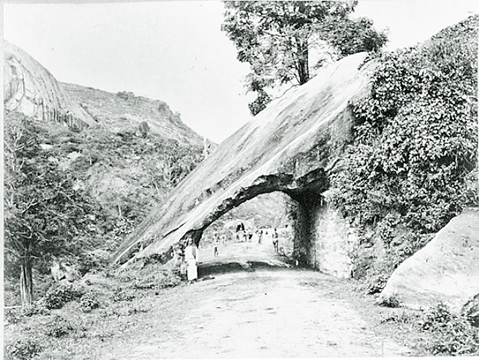|
Musings:
The earliest route from Colombo to Kandy
by Padma Edirisinghe
Now that the third route from Colombo to Kandy is in the offing, the
topic in hand could be really topical. The only hitch is that the very
prosaic topic as roads is dressed in mellifluous poetry. Further, these
poems pertaining to the earliest route have been sung by an unknown folk
poet.
|

Old Kadugannawa rock.
Pic courtesy: Elakiri.com |
However, a bit of prose is given in this introduction by the writer
mentally wandering by herself in the days gone by when Colombo city was
just one of the ports dotting the coastline. Even the Sandesha birds
carrying their messages across the island never noticed it except for
the author of Thisara Sandeshaya who sees it as a busy port as early as
the 16th century. However, no roads were built to connect this city to
other towns.
Menace
In fact, in the olden days of monarchical rule, roads were considered
an interfering menace that spoilt the natural insularity and in most
cases were not given any consideration. If considered at all, they were
branded only as an open invitation to invaders. To the Kandyan kings
especially, harassed by foreign invaders the thick foliage and the
mountains were a godsend. Only guerilla warfare could thrive in it, for
the rocks were gigantic and impregnable providing a natural defence
while the waterways were unaffordable. The ruggedness of the path fitted
the times as motor transport was unheard of.
But as history’s tale unfolded, the mighty Kadugannawa rock was
pierced leading to the British conquest. All this time during the
Portuguese and Dutch periods and the early British period a perilous
journey had been made to Kandy from Colombo that awes one by the sheer
bravado displayed in the adventurous venture. Its first section had been
along the Kelani river bed and ending at Sitawaka (Avissawella). Mouth
of the Kelani was the estuary of Modera while it ran many a mile from
its womb in the central highlands, thus providing an easy passage for
inland travel.
A Viththi potha (book giving information) includes these three poems
that give the route from Sitawaka onward.
First verse
Sitawaka Thalduwath Apalapitiya Ruwanwella
Anguruwella Kannathota Mattamagoda me siyalla
Ampe Atalath Chittangala Udugama piyasa dulla
Arandarin Kekunavalath Narigala yana me siyalla.
Second verse
Vanduradeniyada Iddaya Malyaye pasukara
Atugoda ginnen Batalewala yana gam pasukara
Hettimulla Ahunugalla Divela gamath pera hamu wena
Vagirigala Walathara pattagama elanga paminena
Third verse
Dodagaha ruppe Watarakgoda veediya matakada ena
Walabaduwath maliyadda edanduwavath pasu vena
Manikkavene Ganetanne Makadawatha etha
Balana Amunupura Senkadagala Raja mawatha
Oblivion
How are many of these place names still in existence today? Along
with the ancient route most of them have gone into oblivion.
Translations of the above 3 verses are as follows:
Beginning from Sitawaka, the road upcountry runs via Apalapitiya,
Ruwanwella, Anguruwella, Kannathota, Mattamagoda and passing all these
it rises to the heights of Ampe, Atala,Viththangala and Udugama, the
village of splendour, then onto Arandara, Kekunawala and Narigala.
Then the road passes through Vaduradeniya, Iddaya and Malyaya (the
throng of flowers), onto Angoda and Batalewela, Hettimulla, Ahunugalle,
Divela and reaches the villages of Vakirigala,Valathara and Pathagama.
Now onto Dodagaha ruppe and Watarakgoda street, then passing
Manikkawa Ganetenna and Makadawatha, onto Balana Amunupura and
culminating its journey at the King’s street in Senkadagala.
Aware
The writer is not aware how many of these place names still exist but
in her travels in the environs of Kandy during the past years she has
observed some of these names on bus boards and even on streets in urban
areas.
These include Sitawaka, Anguruwella, Hettimulla, Wakirigala and
Ganetanne. It is purely due to the writer’s ignorance if some names
still in rotation and connected to public use have been left out.
Further, the circumstances that led to the construction of a new road
as an alternative to the aforesaid road passing through Hewagam Korale
and Thun Korale should be presented briefly.
It could be summarily mentioned that the decision to build a new road
to Kandy almost coincided with the subjugation of the 1818 rebellion.
The dangerous phases of this rebellion, the British concluded were
spawned by the lack of direct routes to Kandy to transport military
forces. The old road was too hazardous and too circuitous for quick
action to be initiated from Colombo to the rebel-ridden areas in the
highlands.
Revolution
The industrial revolution raging in Britain could provide the maximum
support for the road building craze begun by Governor Barnes who
succeeded Brownrigg who had to face the 1818 rebellion.
It would be a deep bow to history if at the site of the inception of
this third road (the second one going through Kadawatha, and Kegalle and
labelled today as the No.1 road), if a mini museum can be established
providing a chance for the public to view the old routes. |

